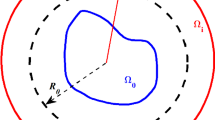Abstract
In this article we study the simplest one-dimensional transport equation u t +au x =f and study the implementation of the boundary condition using a penalty method combined with a P1 finite element discretization. We discuss the convergence of the method when both the penalty parameter ϵ and the mesh size h go to zero, in sequence or simultaneously. Some numerical simulations are reported also showing the efficiency of the method. Numerical simulations are also made for the similar problem in space dimension 2.
Similar content being viewed by others
References
Chen, Q., Qin, Z., Temam, R.: Treatment of incompatible initial and boundary data for parabolic equations in higher dimensions. Math. Comp. 80, 2071–2096 (2007)
Chen, Q., Qin, Z., Temam, R.: Numerical resolution near t=0 of nonlinear evolution equations in the presence of corner singularities in space dimension 1. Commun. Comput. Phys. 9(3), 568–586 (2011)
Chen, Q., Shiue, M.-C., Temam, R.: The barotropic mode for the primitive equations. J. Sci. Comput. 45, 167–199 (2010)
Chen, Q., Shiue, M.-C., Temam, R., Tribbia, J.: Numerical approximation of the inviscid 3d primitive equations in a limited domain. Math. Model. Numer. Anal. (to appear)
Courant, R.: Variational methods for the solution of problems of equilibrium and vibrations. Bull. Am. Math. Soc. 49, 1–23 (1943). MR 0007838 (4,200e)
Funaro, D., Gottlieb, D.: A new method of imposing boundary conditions in pseudospectral approximations of hyperbolic equations. Math. Comput. 51, 599–613 (1988)
Funaro, D., Gottlieb, D.: Convergence results for pseudospectral approximations of hyperbolic systems by a penalty-type boundary treatment. Math. Comput. 57, 585–596 (1991)
Gottlieb, D., Hesthaven, J.S.: Spectral methods for hyperbolic problems. J. Comput. Appl. Math. 128(1–2), 83–131 (2001). Numerical analysis 2000, Vol. VII, Partial differential equations. MR MR1820872 (2001m:65138)
Hesthaven, J.S.: Spectral penalty methods∗ 1. Appl. Numer. Math. 33(1–4), 23–41 (2000)
Hörmander, L.: L 2 estimates and existence theorems for the \(\bar{\partial}\) operator. Acta Math. 113, 89–152 (1965). MR 0179443 (31 #3691)
Lax, P.D., Phillips, R.S.: Local boundary conditions for dissipative symmetric linear differential operators. Commun. Pure Appl. Math. 13, 427–455 (1960). MR 0118949 (22 #9718)
Lions, J.-L.: Quelques méthodes de résolution des problèmes aux limites non linéaires. Dunod (1969). MR 41 #4326
Oliger, J., Sundström, A.: Theoretical and practical aspects of some initial boundary value problems in fluid dynamics. SIAM J. Appl. Math. 35(3), 419–446 (1978). MR 58 #25389
Petcu, M., Temam, R.: The one-dimensional shallow water equations with transparent boundary conditions. Math. Methods Appl. Sci. (MMAS) (2011). doi:10.1003/mma.1482
Polak, E.: Computational Methods in Optimization. A Unified Approach. Mathematics in Science and Engineering, vol. 77. Academic Press, New York (1971). MR 0282511 (43 #8222)
Rousseau, A., Temam, R., Tribbia, J.: The 3D primitive equations in the absence of viscosity: boundary conditions and well-posedness in the linearized case. J. Math. Pures Appl. 89(3), 297–319 (2008). MR MR2401691
Rousseau, A., Temam, R.M., Tribbia, J.J.: Boundary value problems for the inviscid primitive equations in limited domains. In: Handbook of Numerical Analysis, vol. XIV, pp. 481–575. Elsevier/North-Holland, Amsterdam (2009). Special volume: Computational Methods for the Atmosphere and the Oceans. MR 2454280 (2010c:86009)
Shiue, M.C., Laminie, J., Temam, R., Tribbia, J.: Boundary value problems for the shallow water equations with topography. J. Geophys. Res. 116(C2), C02015 (2011)
Temam, R.: Navier-Stokes Equations. AMS, Providence (2001). Theory and numerical analysis, Reprint of the 1984 edition. MR MR1846644 (2002j:76001)
Temam, R., Tribbia, J.: Open boundary conditions for the primitive and Boussinesq equations. J. Atmos. Sci. 60(21), 2647–2660 (2003). MR 2 013 931
Temam, R.: Une méthod d’approximation de la solution des équations de Navier-Stokes. Bull. Soc. Math. Fr. 98, 115–152 (1968).
Author information
Authors and Affiliations
Corresponding author
Rights and permissions
About this article
Cite this article
Chen, Q., Hong, Y. & Temam, R. Analysis of a Penalty Method. J Sci Comput 53, 3–34 (2012). https://doi.org/10.1007/s10915-011-9553-8
Received:
Revised:
Accepted:
Published:
Issue Date:
DOI: https://doi.org/10.1007/s10915-011-9553-8




